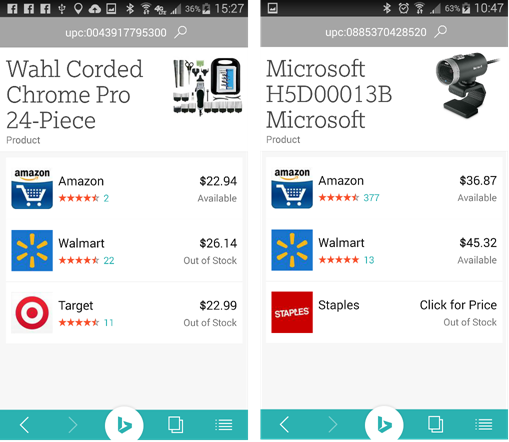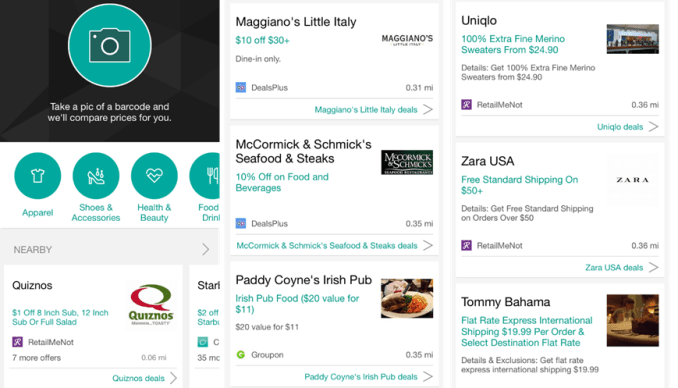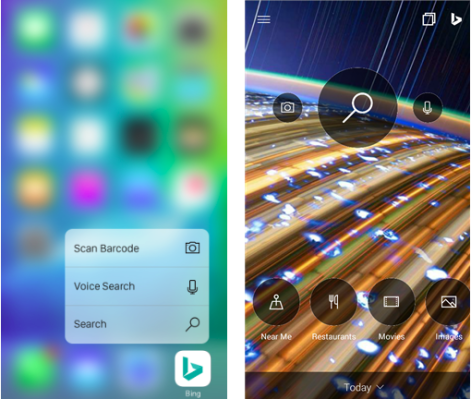Microsoft’s Bing is trying to carve out a niche for itself on mobile by focusing on the types of common searches and information requests people need to access while on the go. To that end, the company this week rolled out new iOS and Android applications with features like a barcode scanner for price comparisons, a tool to find the cheapest nearby gas prices, and, on iOS to start, a new deals browser.
The refresh is more notable for users on Android, as the iOS app previously included some of these features. For example, Bing previously introduced the price comparison feature when it launched version 6.1 of its iOS app in December, which also introduced things like Uber integration, GIF support, a restaurant finder, OpenTable integration, and a music and movie finder.

Now, users on both platforms will have access to that same feature set. With the barcode scanner, which is launched by long-pressing the search icon, Bing will look up the item in question and return ratings and prices from major retailers, including Amazon, Walmart, Target and others. For users on iPhone 6s or 6s Plus devices, the barcode scanner is also now available via 3D Touch – you just force touch the Bing app icon to access the option. Similarly, on Android, you can long press the search icon to launch the scanner.
With the barcode scanner, which is launched by long-pressing the search icon, Bing will look up the item in question and return ratings and prices from major retailers, including Amazon, Walmart, Target and others. For users on iPhone 6s or 6s Plus devices, the barcode scanner is also now available via 3D Touch – you just force touch the Bing app icon to access the option. Similarly, on Android, you can long press the search icon to launch the scanner.
For users on iPhone 6s or 6s Plus devices, the barcode scanner is also now available via 3D Touch – you just force touch the Bing app icon to access the option. Similarly, on Android, you can long press the search icon to launch the scanner.

Both apps also now include integration with GasBuddy for finding the nearest, most affordable gas prices by either searching for “gas,” or by accessing the “gas” option from the “Near Me” section.
Finally, the iOS app has been updated to make it easier to browse deals. This is an expansion on the earlier deals feature, where deals would appear directly in the search results – such as when you searched for a restaurant, for instance. In the new app, you can browse deals right from the homepage of the app itself. This section will also sort the deals by proximity, which can be useful when you’re looking for a deal on dinner, or on something else you’re shopping for
In the new app, you can browse deals right from the homepage of the app itself. This section will also sort the deals by proximity, which can be useful when you’re looking for a deal on dinner, or on something else you’re shopping for, while out and about.
The feature is also powered by integrations with third-parties, including services like RetailMeNot, Groupon, DealsPlus and others. That makes it more useful than launching those individual deal-finding apps on their own.
Microsoft says this feature will arrive on the Android app “soon.”
The company is taking an interesting position in its effort to compete with Google, whose own search app directs people to results hosted on its own site – including, in recent years, information it pulls from web pages and then places at the top of search results in an effort to provide “quick answers” for things like local movie showtimes or nearby restaurants.
Instead, Microsoft is pulling in a lot of its data from third-parties, including also services like Foursquare, Yelp, Facebook, Uber and more. Effectively, it wants to establish itself as the go-to destination for accessing the other apps on your phone.
For instance, if you find a Groupon deal on a local attraction, like a museum, while using Bing, the app could point you to reviews on TripAdvisor and Foursquare; it could help you get there by showing you directions in Apple Maps or Google Maps; help you book you a ride on Uber or Lyft; or show you more information about the destination on sites like Wikipedia, Twitter or the company’s own website.
For an underdog like Bing, this is not a bad strategy – users are becoming overwhelmed with the number of apps on their phone, and are turning to features like virtual assistants, and other portals, like Google Now, to get things done.
The new Bing apps are available now on the iTunes App Store and Google Play.
